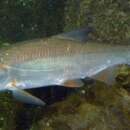Diagnostic Description
provided by Fishbase
Diagnosed from congeners in Black and Caspian Sea basins by the following characters: straight mouth in individuals larger than 20 cm SL, lower lip with thick cornified sheath; dorsal fin with 9½ branched rays; anal fin with 10-11½ branched rays; scales on lateral line 52-66 (usually 60-63); eye large, diameter 50-65% of interorbital distance; and side lacking broad dark midlateral stripe. Differs from species of Chondrostoma, Protochondrostoma and Parachondrostoma in Atlantic, Adriatic and Mediterranean basins of France, Italy and Slovenia by having the following features: mouth straight, lower lip with thick cornified sheath; 27-36 gill rakers; anal fin with 10-11½ branched rays; and pectoral, pelvic, anal and caudal fins red (Ref. 59043). (Ref. 59043). Caudal fin with 19 to 21 rays (Ref. 40476).
Life Cycle
provided by Fishbase
Migrates some tens of km to spawning sites, which are often located in tribbutaries. Males form large aggregations, each male defending a small territory. Females spawn only once a year and in some populations, during a very short period of 3-5 days. Females lay sticky eggs into excavations made in gravel (Ref. 59043).
Migration
provided by Fishbase
Potamodromous. Migrating within streams, migratory in rivers, e.g. Saliminus, Moxostoma, Labeo. Migrations should be cyclical and predictable and cover more than 100 km.
Morphology
provided by Fishbase
Dorsal spines (total): 3; Dorsal soft rays (total): 8 - 10; Analspines: 3; Analsoft rays: 9 - 11; Vertebrae: 47 - 48
Trophic Strategy
provided by Fishbase
Gregarious. Occurs in fairly shallow water with fast current, often beside the swirls created by piles of bridges or rocks (Ref. 30578). Found in the upper reaches of rivers. Feeds on algal growth on stones, which are scraped away with the use of its sharp, low, slit-like mouth. Migrates upstream and enters small tributaries for spawning in shallow water on gravel (Ref. 556).
- Recorder
- Drina Sta. Iglesia
Biology
provided by Fishbase
Gregarious. Adults occur in fairly shallow water with fast current, often beside the swirls created by piles of bridges or rocks (Ref. 30578). They inhabit moderate to fast-flowing large to medium sized rivers with rock or gravel bottom. Larvae occur below surface and feeding larvae inhabit along shores. Early juveniles live on the bottom in very shallow shoreline habitats. When growing, they move from the shore for faster-flowing waters. Juveniles overwinter in backwaters or in cavities along shores. During winter, adults form dense swarms in lower parts of rivers. Larvae and early juveniles prey on small invertebrates while larger juveniles and adults feed on benthic diatoms and detritus. Adults migrate upstream some tens of km to spawning sites which are often located in tributaries. Spawning occurs in fast flowing water on shallow gravel beds (Ref. 556, 59043). Its flesh is good but bony (Ref. 30578). Locally threatened by damming, destruction of spawning sites and pollution. In drainages where they are introduced, they outcompete and eliminate Parachondrostoma toxostoma in Rhône and Protochondrostoma genei in Soca (Ref. 59043).
Importance
provided by Fishbase
fisheries: minor commercial; aquarium: public aquariums
Common nase
provided by wikipedia EN
The common nase (Chondrostoma nasus) is a European potamodromous cyprinid fish. It is often simply called the nase, but that can refer to any species of its genus Chondrostoma. Another name is sneep.
Distribution
The nase is found naturally in drainages of the Black Sea (Danube, Dniestr, Southern Bug, Dniepr), the southern Baltic Sea (Nieman, Odra, Vistula) and the southern North Sea (to Meuse in the west). Moreover, it has been introduced to the Rhône, Loire, Hérault, and Soca/Isonzo (Italy, Slovenia) drainages. It is a migratory fish.
Appearance
The nase has a spindle shaped physique, with a blue-grey metallic-coloured scales and orange tail. It has relatively sharp lower lip. Generally, the fish range from 25 to 40 centimetres in length, and weigh about 1000 grams. However, specimens have been recorded up to 60 long and 3 kg in weight . The maximum recorded life span of the fish is 15 years.
Biology
This gregarious species is found in deep water with a fast current, often in the back waters of bridges or in rocky outcrops. It dwells near the bottom where it feeds on algae, aquatic plants and invertebrates. Nase fish on the whole stay in shoals.
Protection
The nase is protected by the Convention on the Conservation of European Wildlife and Natural Habitats.
References

- license
- cc-by-sa-3.0
- copyright
- Wikipedia authors and editors
Common nase: Brief Summary
provided by wikipedia EN
The common nase (Chondrostoma nasus) is a European potamodromous cyprinid fish. It is often simply called the nase, but that can refer to any species of its genus Chondrostoma. Another name is sneep.
- license
- cc-by-sa-3.0
- copyright
- Wikipedia authors and editors

